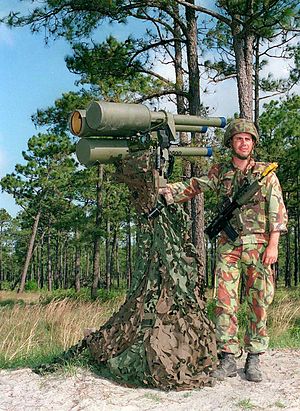Javelin (surface-to-air missile)
| Javelin | |
|---|---|
 British soldier posing with Javelin triple launcher (1996) | |
| Type | Manportable surface-to-air missile |
| Place of origin | United Kingdom |
| Service history | |
| Used by | See Operators |
| Production history | |
| Manufacturer | Thales Air Defence |
| Specifications | |
| Mass | 11.1 kilograms (24 lb) (missile) 24.3 kilograms (54 lb) (system) |
| Length | 1.39 metres (4 ft 7 in) |
| Diameter | 76 millimetres (3 in) |
| Crew | 1 |
| Effective firing range | 300 to 4,500 metres (980 to 14,760 ft) against jets to 5,500 metres (18,000 ft) against helicopters |
| Warhead | High-explosive warhead |
| Warhead weight | 2.74 kilograms (6.0 lb) (containing 0.6 kilograms (1.3 lb) of HE) with contact and proximity fuzes |
Detonation mechanism | Impact force or proximity fuze |
| Engine | Solid fuel rocket |
| Maximum speed | Mach 1.7+ approx. |
Guidance system | SACLOS system |
Javelin is a British man-portable surface-to-air missile, formerly used by the British Army and Canadian Army. It can be fired from the shoulder, or from a dedicated launcher known as Javelin LML: Lightweight Multiple Launcher. Capable of being vehicle mounted, the LML carries three rounds.
It first entered British service in 1984 and was later replaced in front line service by the Javelin S-15, sold commercially as the Starburst surface-to-air missile in 1993 (the radio frequency–guided Javelin was retained for some time thereafter for training purposes), and later by the Starstreak starting around 1997.[1] The Javelin GL was hastily purchased by the Canadian Forces to replace the existing Blowpipe surface-to-air missile system that failed last-minute tests during preparations for the deployment to the Persian Gulf for the First Gulf War (1990–1991).[2][3][4] It was later replaced by the Javelin S15 until retired without replacement in 2005.
History[]
The missile was developed as a replacement for the Blowpipe MANPADS, which had proven largely ineffective in the Falklands War although it was used by both sides. Only two hits were recorded out of more than 100 launches: a British Harrier GR3 (XZ972) attacked by Argentine Army special forces (Commandos Company), and an Argentine Aermacchi MB-339 (0766 (4-A-114)) during the Battle of Goose Green.[5]
Operational use[]
Similar in overall appearance to the Manual Command Line of Sight (MCLOS), radio frequency guided Blowpipe, Javelin is slightly more compact, uses Semiautomatic Command Line of Sight (SACLOS) radio frequency guidance and is fitted with an improved warhead. The operator is equipped with a 6× magnification sight and a long range T.V. camera to locate targets. Although the Javelin's accuracy is somewhat susceptible to smoke, fog, or clouds, it is impossible to decoy it away from a target with flares because it does not use an infrared or UV spectrum seeker. It is potentially susceptible to infrared jammers such as AN/ALQ-144.
Operators[]

Current operators[]
 Botswana
Botswana-
- In 1991 the Botswana Defence Force procured 25 missiles with five launchers[6]
 Peru
Peru South Korea
South Korea Ukraine
Ukraine- [citation needed]
Previous operators[]
See also[]
References[]
- ^ "Thales Javelin". Military Factory (MilitaryFactory.com). Retrieved 25 May 2021.
- ^ Thatcher, Chris (21 December 2017). "Critical Gap: Defending the Threat from Above". Canadian Army Today. Retrieved 21 January 2022.
- ^ "The Navy Today: The Gulf War: Javelin Surface-to-Air Missile". Canadian War Museum. Retrieved 21 January 2022.
- ^ rca_admin (27 September 2020) [1 January 2017]. "Javelin Surface to Air Missile UK". Royal Canadian Artillery Museum. Retrieved 21 January 2022.
- ^ Freedman, Sir Lawrence, The Official History of the Falklands Campaign (Abingdon, 2005). Volume II, pp. 732–735
- ^ MOTLOGELWA, TSHIRELETSO. "Khamas monopolised Botswana Defence Force (BDF) tenders". X air Forces.
- Jane's Land-Based Air Defence 2005–2006, ISBN 0-7106-2697-5
- "Javelin".
- "Javelin Surface-to-Air Missile".
- British Army equipment
- Surface-to-air missiles of the United Kingdom
- Military equipment introduced in the 1980s